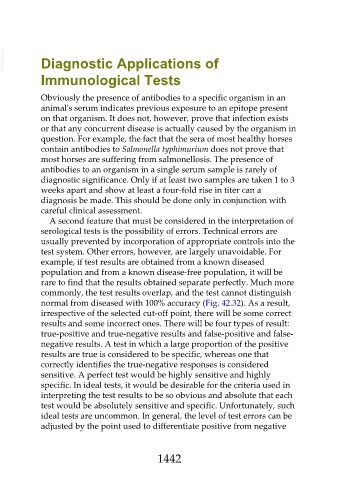Page 1442 - Veterinary Immunology, 10th Edition
P. 1442
VetBooks.ir Diagnostic Applications of
Immunological Tests
Obviously the presence of antibodies to a specific organism in an
animal's serum indicates previous exposure to an epitope present
on that organism. It does not, however, prove that infection exists
or that any concurrent disease is actually caused by the organism in
question. For example, the fact that the sera of most healthy horses
contain antibodies to Salmonella typhimurium does not prove that
most horses are suffering from salmonellosis. The presence of
antibodies to an organism in a single serum sample is rarely of
diagnostic significance. Only if at least two samples are taken 1 to 3
weeks apart and show at least a four-fold rise in titer can a
diagnosis be made. This should be done only in conjunction with
careful clinical assessment.
A second feature that must be considered in the interpretation of
serological tests is the possibility of errors. Technical errors are
usually prevented by incorporation of appropriate controls into the
test system. Other errors, however, are largely unavoidable. For
example, if test results are obtained from a known diseased
population and from a known disease-free population, it will be
rare to find that the results obtained separate perfectly. Much more
commonly, the test results overlap, and the test cannot distinguish
normal from diseased with 100% accuracy (Fig. 42.32). As a result,
irrespective of the selected cut-off point, there will be some correct
results and some incorrect ones. There will be four types of result:
true-positive and true-negative results and false-positive and false-
negative results. A test in which a large proportion of the positive
results are true is considered to be specific, whereas one that
correctly identifies the true-negative responses is considered
sensitive. A perfect test would be highly sensitive and highly
specific. In ideal tests, it would be desirable for the criteria used in
interpreting the test results to be so obvious and absolute that each
test would be absolutely sensitive and specific. Unfortunately, such
ideal tests are uncommon. In general, the level of test errors can be
adjusted by the point used to differentiate positive from negative
1442

